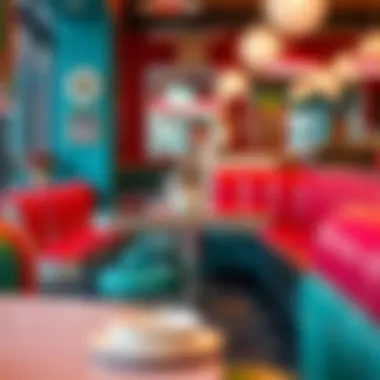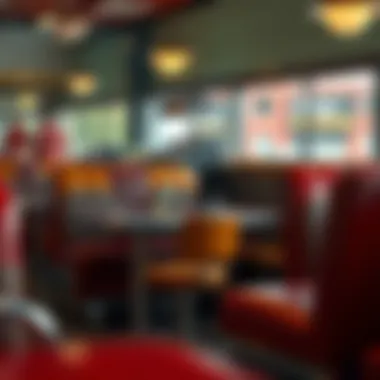Discovering the Timeless Charm of 50s Diner Furniture


Intro
The 1950s was not just a decade; it was an era that redefined culture in terms of music, fashion, and interior design. In particular, the diner scene burgeoned, giving rise to a unique furniture style that captivates many to this day. Those vibrant colors, chrome finishes, and retro motifs don’t merely echo nostalgia; they resonate with a lifestyle—a simpler, more joyous time that many strive to recapture even in a modern context. As we explore the appeal of 50s diner tables and chairs, we will delve into their historical context, design features, and the reasons behind their ongoing popularity among contemporary homeowners and decorators alike.
It's not just about furniture; it's about creating an atmosphere in which people can gather, reminisce, and create new memories. In a world flooded with fleeting trends, these classic pieces retain a distinct charm, forming a nostalgic link to the past while seamlessly adapting to today’s home environments. You'll find practical advice on how to integrate these pieces into your home, along with specific buying tips and maintenance guidelines that will keep your diner-style furniture looking sharp for years to come.
Historical Overview of 50s Diner Furniture
The era of the 1950s is often viewed through a lens of nostalgia, primarily for its vibrant culture, music, and, notably, its diners. The importance of diner furniture, specifically tables and chairs, lies in the way they reflect the social and economic dynamics of that time. As Americans began to embrace the post-war boom, diners transformed into social hubs. This evolution showcased not only a shift in dining habits but also a stylistic revolution in furniture design.
The Cultural Significance of Diner Aesthetics
Diner aesthetics symbolize more than just a design choice; they embody an entire cultural ethos. The layout and decoration of diners during the 50s were a direct response to societal changes. Families, couples, and friends gravitated toward these establishments, making them essential in shaping a communal identity. Often adorned with checks, chrome accents, and vibrant color schemes, diner furniture exudes a lively charm that draws patrons in.
Furnishings like the classic red-and-white vinyl seats or shiny metal tables evoke memories of milkshakes, burger flips, and jukebox tunes. These pieces tell a story that extends beyond their physical presence. Each table supports not just plates, but shared experiences and laughter. The nostalgia associated with these diner aesthetics continues to attract homeowners and decor enthusiasts today, making it essential to understand this cultural significance when exploring the 50s diner furniture market.
Evolution of Design: From Diners to Home
The evolution of diner furniture from public establishments to private homes illustrates a fascinating journey of allure and adaptation. As diners began to close their doors in favor of fast food chains, the aesthetic and functional appeal of diner-style furniture found its way into suburban homes and contemporary settings.
- Adaptation: Homeowners started integrating diner tables and chairs into their kitchens and dining rooms to create inviting environments that echoed the heartiness of a diner’s atmosphere.
- Design Trends: The shift marked a blend of practicality with retro flair. Kitchen layouts shifted from purely function-driven to spaces that celebrate style.
- Ease of Maintenance: Materials such as Formica for tabletops and vinyl for upholstery provided easy-to-clean solutions, making diner furniture not just attractive but also practical for home use.
As space constraints and lifestyle changes continue to influence home design, the diner furniture of the 50s remains relevant, effortlessly blending into a variety of interior styles. Thus, understanding this evolution is crucial for anyone interested in incorporating these items into modern settings.
"The charm of 50s diner furniture not only lies in its design but in the memories it rekindles— a timeless bridge between past and present."
Through a comprehensible journey from diner to home, this historical overview sets the stage for appreciating the value and significance of 50s diner tables and chairs available for sale.
Defining Characteristics of 50s Diner Tables and Chairs
The charm of 50s diner furniture serves as more than just nostalgic appeal; it's rooted in unique qualities that enhance any space. These tables and chairs are characterized by specific elements that make them both functional and visually appealing. When homeowners, decorators, and retailers consider adding these pieces to their collections, understanding their defining features becomes crucial. This section explores the various materials, colors, and designs that contribute to the unmistakable essence of 50s diner tables and chairs.
Materials Used in Construction
Metal
Metal is a cornerstone material in the construction of 50s diner furniture. It not only plays a role in durability but also adds a nostalgic flair. Steel, often chrome-plated, is a key characteristic adding that shiny, retro look. This metal is particularly popular because of its ability to withstand wear and tear while providing a sleek finish that captures the essence of the era. The shiny, reflective surface of chrome exudes an effortless charm and is resistant to rust, which means it stays looking fresh longer. However, the downside may be that it can become hot to the touch in higher temperatures, making it somewhat uncomfortable in direct sunlight.
Formica
Formica is another iconic material used extensively in the tables of the 50s diner sets. Known for its laminate finishes, Formica offers a vibrant array of colors and patterns. The practicality of this material lies in its stain resistance and easy maintenance. A unique feature of Formica is its ability to mimic textures like marble or wood grain, allowing for a customizable experience without the hefty price tag. While this material is a major favorite for its aesthetic versatility, some might argue that its durability can be questioned under high-impact scenarios compared to solid wood options.
Vinyl
When it comes to seating, vinyl reigns supreme. Often used in cushions and coverings, this synthetic material provides comfort while reflecting the styles of the 50s beautifully. The key characteristic of vinyl is its versatility in color options and prints, allowing for customization that fits diverse decor styles. Another beneficial aspect is its waterproof and easy-to-clean nature, making it a practical choice for families and diners. On the flip side, extreme heat may lead to cracking, which is something to consider for those living in warmer climates.
Iconic Colors and Designs
Classic Color Schemes
Classic color schemes are immediately recognizable in diner furniture, often featuring combinations of bold reds, blues, and creamy whites. These combinations are not just about looks—they evoke a sense of nostalgia linked to Americana and the Fast Food culture of the mid-20th century. The vibrancy of these colors can instantly lift a room's vibe, making them a preferred choice for homeowners looking to create a lively atmosphere. A downside to these bright colors is that they may require regular cleaning to keep them looking fresh and can fade over time if exposed to direct sunlight.
Patterns and Motifs
Patterns and motifs are key sources of the unique visual identity of 50s diner furniture. From checkered patterns to polka dots and other retro prints, these designs contribute to the overall charm of the pieces. A well-chosen motif can truly make a statement, serving as the focal point for a dining space. They allow for creativity in styling, whether used as a bold statement or as part of an eclectic mix. However, homeowners should be cautious as overusing patterns can overwhelm a space, so balance is essential.
"Incorporating 50s diner furniture isn't just about style; it's about crafting a narrative rich with historical significance and personality."


Ultimately, understanding these defining characteristics of 50s diner tables and chairs can guide designers, retailers, and home decorators in making thoughtful choices that resonate with both the functionality and aesthetic of modern spaces. By focusing on materials, colors, and designs, one can appreciate how these elements contribute to their enduring allure.
Why Invest in 50s Diner Furniture
Investing in 50s diner furniture is like capturing a piece of history and infusing it into your living space. The allure of these vintage tables and chairs goes beyond mere nostalgia; they embody a unique blend of functionality, aesthetic charm, and durability. As homeowners and decorators increasingly seek out distinctive pieces that tell a story, diner furniture stands out for its timeless appeal and practical advantages. Whether you are sprucing up a kitchen, creating a retro dining space, or adding character to a contemporary room, 50s diner furniture can serve your needs with both style and substance.
Timeless Appeal of Vintage Style
The vintage style that defines 50s diner furniture resonates deeply with many people. It's not just about the look of the furniture, but the emotions it evokes. Hints of classic diners filled with laughter, the smell of freshly brewed coffee, and the delightful clatter of plates instantly transport us back in time. Each piece carries a story—often layered with memories of communal meals and shared experiences.
Moreover, the art deco and mid-century modern influences that shape these designs give them an aura of sophistication. From the chrome details to the vibrant colors like teal, red, and yellow, the aesthetic appeals not only to die-hard retro fans but also to a new generation seeking unique decor.
"Vintage never goes out of style; it simply gets reinterpreted."
A diner table and chairs don’t just act as furniture; they contribute to the overall ambiance of your space, igniting warmth and cheerful vibes. Unlike some modern designs which can lean toward minimalism, diner furniture invites interaction. It speaks of comfort and joy, making diners not just functional areas but also places where life happens.
Durability and Functionality
Durability is another ace up the sleeve of 50s diner furniture. Often crafted from materials like steel, molded plastic, and vinyl, these pieces are built to withstand the tests of time and everyday use. Many vintage diner tables, for instance, have surfaces made of Formica, a laminate created to be resistant to scratches, heat, and spills. That means a busy family kitchen or a bustling dinning area won't be pushing these tables to their limits.
Additionally, the functionality of diner furniture is unmatched. Most pieces are designed with everyday life in mind. They often feature easy-to-clean surfaces, making them suitable for casual dining settings. The spacious tables can accommodate everything from elaborate meals to game nights with friends. Chairs generally come with back support and cushioned seats—designed for comfort during long gatherings.
In short, when you invest in 50s diner furniture, you're not just buying a product; you're acquiring long-lasting, stylish pieces that enhance both functionality and charm in your daily life. Plus, the ability to marry these pieces with modern design elements allows for a personal touch, making your space uniquely yours.
For those looking to explore more about vintage design, sites like Britannica and Wikipedia can offer deeper insights into the cultural significance of diner decor. As trends evolve, keeping an eye on current market dynamics through platforms like Reddit and Facebook can be beneficial.
Current Market Trends
As the popularity of mid-century modern design continues to capture the hearts of many, the market for 50s diner tables and chairs has seen a noticeable resurgence. This revitalization is not merely a fleeting trend but a reflection of deeper shifts in consumer preferences, driven largely by a desire for nostalgic yet functional home furnishings. Understanding current market trends provides key insights into pricing, availability, and the nature of consumer demand within this specific realm of vintage furniture.
Popular Retailers and Pricing Analysis
The competition for quality 50s diner furniture is fierce, especially among popular retailers who have recognized the appeal of retro styles. Shops like Wayfair and Overstock feature a variety of diner tables and chairs, often showcasing stunning replicas alongside authentic vintage pieces. Pricing varies widely, akin to the range of options available:
- Replica 50s diner sets typically range from $200 to $600, depending on the materials and craftsmanship. These sets, while not nostalgic originals, carry enough charm to capture the style of the era without breaking the bank.
- Authentic vintage diner furniture, however, can go for significantly more. Depending on condition and rarity, prices can easily soar from $600 to several thousands of dollars. For instance, a well-preserved, original table from the 1950s, complete with its unique Formica top, could demand an impressive price, fueled by collectors' interest.
"Finding that perfect diner table isn’t just about aesthetics, it’s about unearthing a piece of history that brings warmth to any space."
Moreover, online auction platforms and high-end vintage boutiques bring additional variety. Here, the shopper has the advantage of comparing prices across different locations without the hassle of in-person visits. This aspect also plays into trends in sustainability. Many consumers are leaning towards second-hand and restored pieces to minimize their ecological footprint, valuing the fusion of style and responsibility in their purchasing decisions.
Online vs. Brick-and-Mortar Purchases
In this digital age, how one shops for 50s diner tables and chairs decidedly influences the purchasing experience. While traditional brick-and-mortar stores offer the tactile satisfaction of physically inspecting furniture, the convenience of online shopping cannot be overlooked. Let’s draw out the comparisons:
Online Shopping Pros:
- Wider Selection: Websites like Etsy and eBay allow buyers from all corners to peruse a vast array of items that might not be locally available.
- Convenience: Shopping at any hour, from the comfort of one’s home, is a strong appeal for today's busy individuals.
- Research and Reviews: Shoppers can read customer experiences, which aids in making informed decisions and assessing a product’s quality.
Brick-and-Mortar Shopping Pros:
- Physical Examination: There’s merit in feeling materials and testing comfort before buying – vital for furniture!
- Personal Interaction: Face-to-face interaction with staff can yield valuable insights that might not be available online, from warranty information to care tips.
- Immediate Gratification: Once purchased, you walk away with your find instead of waiting for delivery.
Selecting the Right Diner Table and Chair Set
Choosing the right diner table and chair set is not just about aesthetics; it's about creating an environment that resonates with your personal style and meets functional needs. This step is vital in the journey of enhancing a space with pieces that embody nostalgia and warmth. Proper selection can elevate a room from ordinary to extraordinary, allowing you to immerse yourself in the charm of the 50s while enjoying modern conveniences.
Assessing Space and Aesthetics
When considering diner furniture, start with a thorough assessment of your available space. Each piece, ideally, should harmoniously fit into your room without overcrowding it. This involves measuring the area designated for the set, taking into account the clearance around the table and chairs for easy movement. A tight fit can create a cramped feeling that’s counterintuitive to the free-spirited vibe of a diner.


In terms of aesthetics, think about the existing decor. If your home exudes a farmhouse ambiance, perhaps a pastel-colored table would juxtapose beautifully against wooden elements. On the contrary, for modern interiors, a chrome-edged table with an eye-catching Formica tabletop could serve as a stunning contrast. The goal here is to complement your surroundings rather than clash with them.
"The right diner set acts as a bridge between past charm and present comfort."
Functionality for Different Uses
Another critical factor in picking your diner set is its functionality. Consider how you intend to use the table and chairs. Is this for daily meals, or will it double as a workspace for your remote job? A practical solution might be a bistro-style dining set, which can accommodate snug spaces while offering versatility. You might even consider a rectangular table; ideal for larger families or entertaining guests.
Additionally, think about the durability of materials used in the construction of the set. Are you looking for something easy to maintain? Vinyl upholstery is not only comfortable but also easy to wipe clean after hectic meal times. On the flip side, if you want to host frequent gatherings, opt for sturdy metal frames to withstand daily use and occasional spills.
Ultimately, balancing these elements will help create a diner table and chair set that functions seamlessly within your lifestyle while looking stunning in your space.
Incorporating Diner Furniture into Modern Spaces
Incorporating diner furniture into modern spaces brings a delightful twist that taps into nostalgia while offering practical functionality. Diner tables and chairs, with their retro aesthetic, serve as conversation starters, invoking memories of simpler times. Their vibrant colors and distinct designs can infuse any contemporary space with personality, transforming a standard room into something special. Creating a space that effectively combines these vintage pieces can elevate both style and comfort, making it an ideal choice for homeowners, decorators, and designers alike.
Creating Retro-Inspired Dining Areas
When it comes to crafting a retro-inspired dining area, one might think of classic diners with their chrome finishes and checkered floors. To bring this vibe home, consider using diner-style tables paired with matching chairs. This pairing not only sets the mood but also creates a cohesive environment that feels inviting. Here are some things to consider when designing your dining area:
- Color Palette: Opt for colors typical of the 50s such as teal, red, and pastel shades. These hues harmonize beautifully with the chrome and vinyl materials that are signature to diner furniture.
- Accessories: To further enhance the retro experience, incorporate items like vintage tableware, jukeboxes, or diner-themed wall art.
- Lighting: A pendant light with a classic flair can help accentuate the diner aesthetic, adding warmth and dimension to the space.
Implementing these elements can create not just a dining area, but an experience where family and friends gather over meals with a touch of nostalgia.
Blending Styles for an Eclectic Look
Blending diner furniture with modern design elements can yield striking results, appealing to those who enjoy an eclectic aesthetic. It's about finding harmony between the retro and contemporary while ensuring both styles accentuate each other. Consider the following tips when merging these styles:
- Contrast in Materials: Pair diner chairs made of shiny chrome with a rustic wood table. This juxtaposition creates visual interest and depth.
- Mix and Match: You don't have to have a matched set. For instance, you can place diner chairs at a modern dining table to create an unexpected yet pleasing blend.
- Artistic Decor: Utilize contemporary art pieces or textiles that resonate with modern tastes to bridge the gap between the decades. This contrast can amplify the charm of vintage chairs and tables while keeping the space fresh and current.
Creating a space that deftly incorporates diner furniture alongside modern elements allows for personal expression and style. The key is to remain open to experimentation and trust your instincts; this is where unique design truly shines.
"Incorporating unique styles can breathe new life into any space, allowing you to tell a story through your furniture choices."
In summary, the charm of 50s diner furniture lies in its versatility and appeal. By skillfully integrating these pieces into modern spaces, homeowners can create environments that pay homage to the past while embracing the present.
Maintenance and Care Tips
Maintaining the charm of your 50s diner tables and chairs is crucial for ensuring their lifespan and aesthetic appeal. These pieces of furniture not only evoke a sense of nostalgia but also are often a centerpiece in modern dining areas. Regular care keeps them looking fresh and vintage at the same time. Here, we’re diving into the cleaning techniques that help preserve these retro favorites, along with how to tackle some common issues that may arise.
Cleaning Techniques for Longevity
When it comes to 50s diner furniture, cleanliness is next to stylishness. Each material used in their construction requires distinct care routines. Here are some strategies for keeping them pristine:
- Metal Parts: For metal legs and fixtures, a gentle soap solution works wonders. Use a soft cloth or sponge to wipe down surfaces, then dry with another cloth to prevent spotting.
- Formica Surfaces: A mixture of vinegar and water is particularly effective. Simply spray it on, wipe with a soft cloth, and let it air dry. Avoid abrasive cleaners as they can cause scratches that mar the surface.
- Vinyl Upholstery: Wipe down with a mild soap solution, followed by a damp cloth rinse. If stains persist, try a specialized vinyl cleaner, following the instructions on the label.
"Regular cleaning not just keeps your diner furniture looking good but aids in preventing long-term damage."
- Frequency: Aim to clean your diner table and chairs at least once a month. This routine can prevent buildup of dirt and oil, keeping everything in top shape for years to come.
Addressing Common Issues
Despite the durable nature of 50s diner tables and chairs, some issues may crop up over time. Here’s how to address them effectively:
- Scratches on the Table Surface: For minor scratches, use a color-matched touch-up marker to blend the imperfections. For deeper scratches, a specific furniture wax or resin can fill and hide the blemish.
- Faded Upholstery: If the vibrant colors seem to dull over time, it might be helpful to use fabric dye or upholstery paint suited for vinyl. Always conduct a patch test in an inconspicuous area before proceeding.
- Metal Rust: If you notice rust forming on metal parts, gently sand the affected area and apply a coat of protective spray paint designed for metal surfaces. This not only restores appearance but also prevents further corrosion.
- Stability Issues: If chairs wobble or feel unstable, check the screws and joints. Tighten as necessary, and consider using furniture glides if you notice the legs wear down unevenly.
Regular maintenance paired with prompt attention to issues ensures that your investment in 50s diner furniture continues to yield joy and complement your space beautifully. Taking time to care for these pieces honors their history while bringing a touch of retro flair into your home.
Personalizing Your Diner Table and Chairs


Personalizing your diner table and chairs adds an extra layer of charm and character that can transform these nostalgic pieces into a focal point of any room. Given the historical significance and unique design of 50s diner furniture, tailoring these items to reflect your taste not only enhances their appeal but also brings a sense of warmth and individuality to your space. When it comes to making these pieces your own, several key elements, benefits, and considerations come into play.
Choosing Custom Upholstery
One of the most impactful ways to personalize diner chairs is through custom upholstery. This not only refreshes the look of your vintage furniture but allows you to select fabrics that align with your home’s aesthetic. Here’s a breakdown of the considerations:
- Fabric options: Think about the textures and patterns that will complement your decor. From retro polka dots to sleek solid finishes, the choices are vast.
- Durability: Heavy-duty fabrics like vinyl or leather can withstand everyday use, making them ideal for households with children or pets.
- Color coordination: Choose colors that tie in with your dining area. Whether you prefer a vibrant hue or a muted tone, custom upholstery can harmonize the look.
Customizing upholstery creates a connection between the furniture and the owner, as the materials can express a multifaceted personality - something that standard upholstery typically lacks.
Accessorizing with Table Settings
Once your diner table and chairs are personalized, the next step is to accessorize them with thoughtful table settings. These accessories not only enhance the look of your dining area but also set the mood for any gathering. Here are some ways to spruce up your diner table:
- Table Linens: Consider vibrant tablecloths or placemats that can add color and texture. Retro diner-themed patterns can echo the charm of the era while enhancing the dining experience.
- Dishware: Vintage-style dishes or even mismatched china can bring an interesting twist. Play around with colors and patterns that scream retro.
- Centerpieces: A simple but striking centerpiece, such as fresh flowers in a simple vase or a nostalgic diner-related item, can tie together the whole aesthetic.
- Lighting: Don't forget about the lighting! A retro table lamp or pendant light above can create an inviting atmosphere, perfect for a cozy meal.
In summary, personalizing your diner table and chairs is about weaving your identity into this classic style. Whether you opt for custom upholstery, lively accessories, or a mix of both, each piece becomes an extension of your taste - harmonizing the nostalgia of the 50s with the vibrancy of your unique style.
Exploring Alternative Styles
Navigating the world of vintage furniture can feel like venturing into a treasure chest filled with unique finds. Among these treasures, 50s diner tables and chairs have their own special charm. However, as we dig deeper, we discover that the appeal of this style doesn't just stop at its own distinctive look—it serves as a gateway to understanding other vintage styles that came before and after it. By appreciating the broader context of vintage furniture styles, one can enhance the selection process and truly curate a space that resonates on a personal level.
Comparing With Other Vintage Furniture Styles
When discussing diner furniture, it’s worth comparing it with other vintage styles, like Mid-Century Modern or Art Deco. Each of these styles brings its own flavor to the mix.
- Mid-Century Modern: This style is characterized by clean lines and organic forms, often using materials such as molded plywood and fiberglass. While both diner furniture and Mid-Century pieces celebrate simplicity and functionality, diner tables often incorporate bright colors and loud patterns, reflecting a more casual and playful atmosphere.
- Art Deco: Emphasizing luxury and glamour, Art Deco furniture features bold geometries and rich materials. In contrast, diner pieces tend to focus on comfort over opulence. However, it’s fascinating how diners embraced elements of glamour through chrome accents and shiny surfaces.
These comparisons aren’t just academic; they serve to highlight what makes diner tables and chairs unique. Each style reflects a time in history and a mindset that shapes our experience with furniture.
Influences from Other Decades
The design language of 50s diner furniture isn't cocooned in a vacuum. It draws upon various influences from other decades, which is key to understanding its appeal.
- The 1940s: Here, we see a practicality that emerged from war rationing. Materials shifted to more affordable options, paving the way for Formica surfaces and metal constructions that became hallmark features of diner furniture. The shift towards casual dining also started here, reflecting a cultural change towards relaxed social settings.
- The 1960s: The exploration of bold colors and funky patterns in the following decade reinvigorated interest in diner aesthetics. Neon lights and psychedelic colors may not have been part of the original diner vibe, but they certainly contributed to the evolution of the aesthetic that followed.
By appreciating these influences, we gain a richer understanding of how diner furniture fits within the tapestry of design history. Through this lens, diner tables and chairs aren’t just relics; they become connections to broader trends, making them all the more significant in modern spaces.
"Understanding vintage furniture styles is like piecing together a family tree of design. Each piece tells a story that speaks through time and culture."
In summary, delving into alternative styles, including their comparisons and influences from past decades, adds depth to the appreciation of 50s diner furniture. It’s not just about nostalgia; it’s about recognizing a continuum of creativity and adaptation that resonates even today. When you integrate these insights into your choice of diner tables and chairs, you enrich not just your space but also your understanding of design as a whole.
Finale and Future Trends
The narrative of 50s diner tables and chairs does not merely conclude with a reflection on their nostalgia; instead, it thrusts us into a broader discourse of design relevance that persists through time. Understanding the context and significance of these pieces provides insight not only into historical trends but also contemporary applications, making them a valuable investment for those who cultivate an appreciation for vintage aesthetics. These diner-style furnishings serve not only to invoke memories of simpler times but also to enhance the character and charm of modern spaces.
The Continued Relevance of 50s Diner Aesthetics
The classic appeal of 50s diner furniture remains steadfast in today’s market, melding seamlessly into both retro-themed spaces and eclectic modern homes. When you walk into a space adorned with these vibrant pieces, it often evokes a sense of warmth and camaraderie. Homeowners and decorators alike draw on the inviting aura these furnishings provide, making them a desirable choice for dining rooms, cafes, and even home offices. Furthermore, as consumers gravitate toward authenticity, the genuine vintage character of 50s diner furniture offers a refreshing contrast to sterile, mass-produced items.
"As much as trends come and go, the heart of diner furnishings — robust materials, cheerful colors and nostalgic vibes — continues to resonate with many."
This revival can particularly be witnessed in social media contexts where designs steeped in nostalgia gain traction. Platforms like Instagram, Reddit, and Pinterest are treasure troves of images showcasing diner chairs and tables styled in contemporary homes, showing off their versatility. Designers often take inspiration from these pieces, helping maintain their relevance in the fast-evolving world of interior decor.
Sustainable Practices in Vintage Furniture Retail
In our age, where sustainability is of utmost importance, vintage furniture like 50s diner tables and chairs align with a conscientious approach to consumption. As people become increasingly aware of the environmental impact associated with manufacturing new items, the allure of repurposing and embracing vintage objects shines brighter than ever.
- Repurposing: Not only does resale extend the lifespan of these items, but it also reduces the waste produced by contemporary production. Each piece carries its own story, undoubtedly unique and rich in character.
- Restoration: Many exuberant craftsmen and DIY enthusiasts opt to restore rather than replace, ensuring that the charm of 50s diner pieces is preserved while contributing to sustainability.
Purchasing from retailers who practice ethical sourcing and restoration often guarantees that these durable items reflect a commitment to responsible consumption. On many refurbished pieces, you’ll notice how little effort is needed to maintain their classic appeal, thus minimizing resources used in upkeep.
By incorporating sustainable practices, retailers and consumers contribute to a cycle of appreciation and care that honors the craftsmanship behind these beloved diner pieces and nurtures the ecosystem at large.
As we move forward, the charm of 50s diner furniture continues to evolve—an enduring element of our culture that reflects not just a moment in time but a growing commitment to creativity, sustainability, and the elegance of nostalgia.















